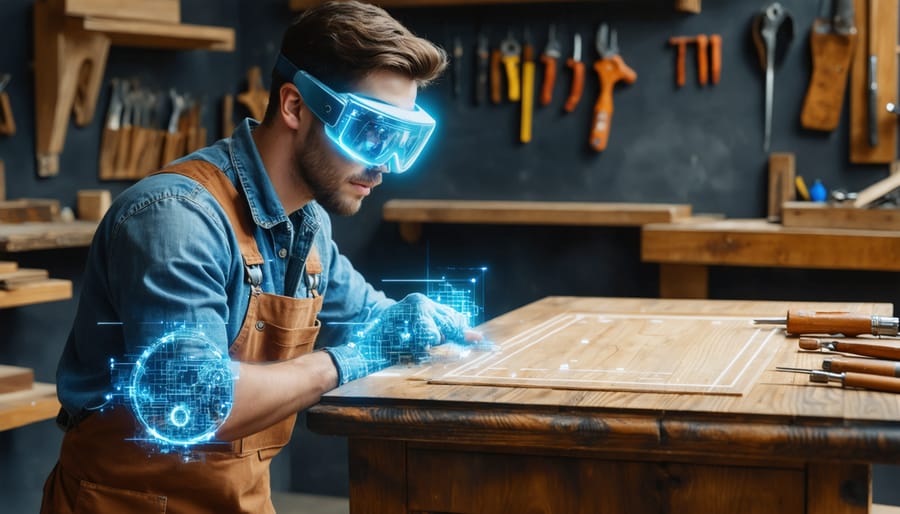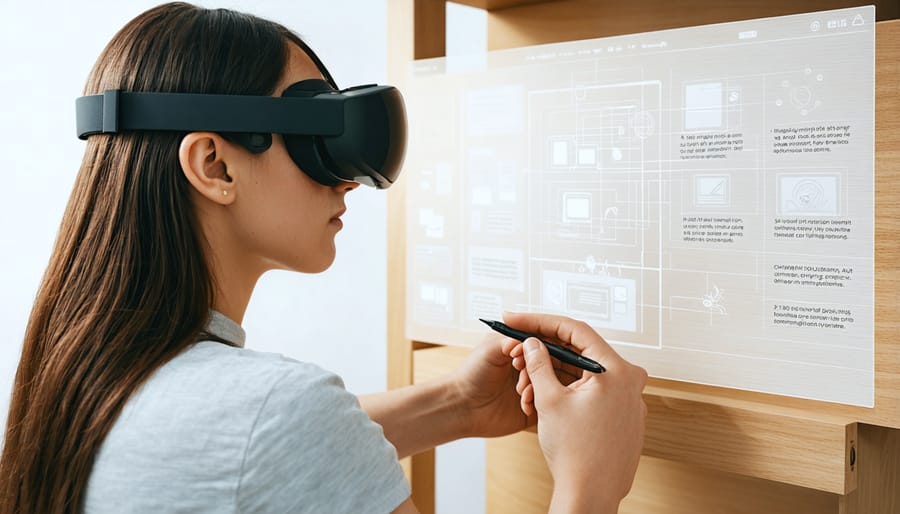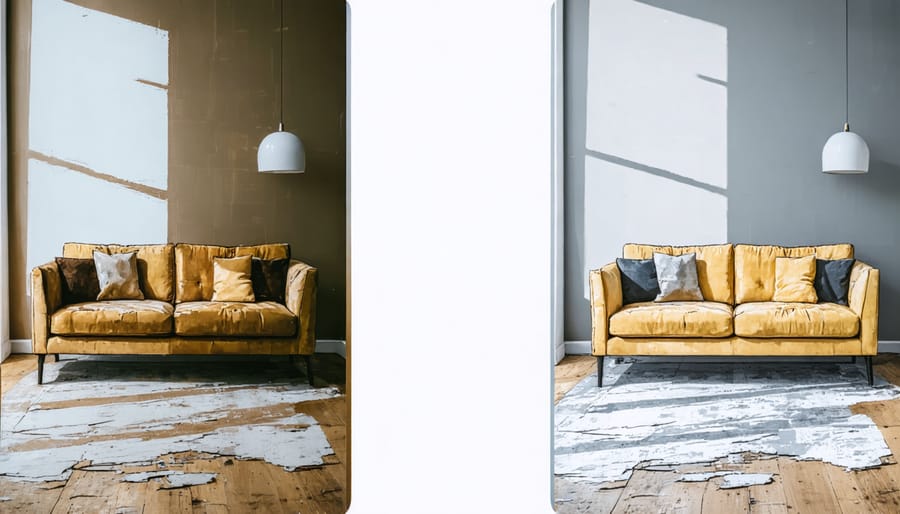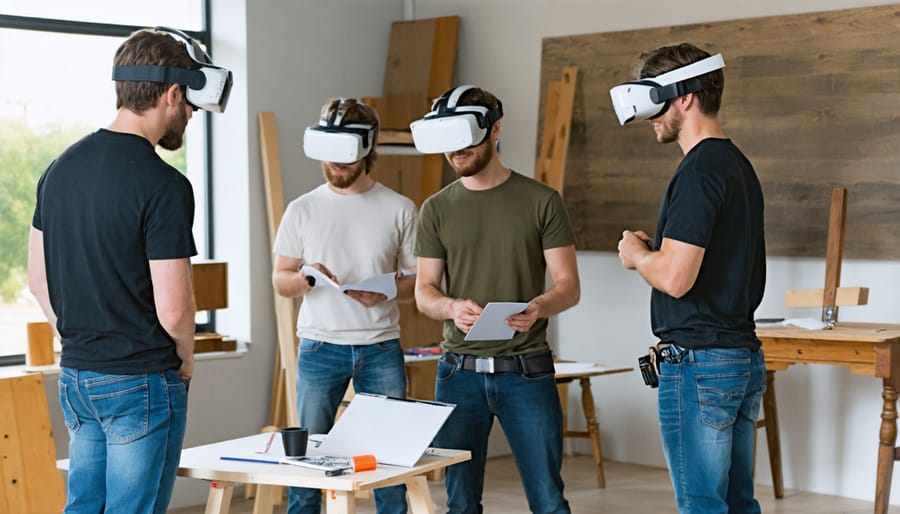
Augmented reality is revolutionizing professional training across industries, with furniture restoration leading the transformation. By overlaying digital instructions onto real-world objects, AR technology enables apprentice restorers to master complex techniques with unprecedented precision and confidence. From intricate wood grain matching to period-accurate finish applications, trainees can now visualize each step of the restoration process before touching valuable antiques.
This breakthrough training approach reduces learning curves by up to 60% while minimizing costly mistakes on irreplaceable pieces. Industry leaders report that AR-trained professionals demonstrate superior attention to detail and higher customer satisfaction rates compared to traditionally trained counterparts. The technology’s ability to provide real-time feedback and step-by-step guidance has made it particularly valuable for specialized restoration techniques like marquetry repair and historical finish reproduction.
For business owners and training institutions, AR represents a scalable, cost-effective solution to address the growing demand for skilled furniture restoration professionals while maintaining the highest standards of craftsmanship.
Augmented reality revolutionizes furniture restoration training by providing real-time, interactive visual guidance that transforms the learning experience. Through AR headsets or mobile devices, trainees can see precise overlay instructions that highlight exactly where and how to perform specific restoration techniques. These digital restoration tools project virtual markers, measurements, and even 3D demonstrations directly onto the piece being restored.
For example, when refinishing a vintage dresser, AR technology can outline the correct sanding pattern, display optimal pressure points, and indicate precise areas requiring special attention. Color-coded overlays help identify different wood types and appropriate treatment methods, while virtual arrows guide hand movements for techniques like French polishing or veneer repair.
The system can also detect and alert trainees to common mistakes in real-time, preventing costly errors and ensuring proper technique development. This immediate feedback creates a more confident learning environment, allowing practitioners to master complex restoration skills more efficiently than traditional training methods alone.

Augmented reality training provides an unparalleled hands-on learning experience by overlaying virtual furniture pieces, tools, and repair scenarios onto real-world workspaces. Trainees can practice complex restoration techniques without the risk of damaging actual furniture, receiving instant feedback on their movements and decisions. For example, when learning wood grain matching, AR technology projects ideal patterns onto the work surface, guiding apprentices through proper alignment techniques.
The interactive nature of AR allows learners to repeat procedures multiple times, with virtual indicators highlighting correct tool positions and pressure applications. When working on upholstery repairs, trainees can see precise cutting lines and tension points visualized in real-time, enhancing their understanding of proper techniques. The system provides immediate corrections for common mistakes, such as improper sanding patterns or incorrect chemical application sequences.
This immersive approach accelerates skill development by combining visual guidance with physical practice, making it particularly effective for mastering intricate restoration procedures. Progress tracking features allow trainers to monitor performance metrics and adjust teaching methods accordingly, ensuring consistent skill development across all aspects of furniture restoration.
Augmented reality has revolutionized how we approach restoration techniques, particularly when it comes to surface repair training. Through AR-enabled devices, trainees can now see step-by-step visual overlays that guide them through complex repair procedures. These digital instructions appear directly over the damaged surface, showing exactly where and how to apply specific treatments.
For instance, when addressing wood scratches, AR technology projects precise application zones and recommended pressure levels for different repair compounds. Color-matching becomes more accurate as AR systems can analyze the surrounding wood grain and suggest the optimal stain mixture to achieve seamless results.
The technology particularly shines in teaching leather and upholstery repairs. Trainees can see virtual markers indicating proper needle placement for invisible mending or guidelines for applying leather fillers. AR overlays demonstrate correct texturing techniques, ensuring repairs match the original surface pattern.
What makes this approach particularly effective is the real-time feedback. As learners work on repairs, the AR system can highlight errors immediately and suggest corrections. This interactive guidance significantly reduces the learning curve while building confidence in handling various surface materials.
For business owners, this translates to faster training cycles and more consistent repair quality across their team. The visual nature of AR instruction helps overcome language barriers and ensures standardized repair procedures across multiple locations.
Augmented reality has revolutionized the way professionals learn and perfect color matching and finishing techniques in furniture restoration. Through AR-enabled devices, trainees can now practice mixing colors and applying finishes in a virtual environment that precisely simulates real-world conditions.
The technology projects digital overlays onto actual furniture pieces, showing exactly where and how to apply different finishing techniques. Trainees can see in real-time how various color combinations will look on different wood types and surfaces, eliminating the guesswork and reducing material waste during the learning process.
What makes this particularly valuable is the ability to practice complex color matching scenarios without the risk of damaging actual furniture pieces. For instance, when matching an aged cherry finish on an antique dining table, the AR system can guide the trainee through the exact steps, showing the proper mixing ratios and application techniques needed to achieve the perfect match.
The interactive nature of AR training allows for immediate feedback and correction. If a trainee applies too much stain or uses incorrect pressure during application, the system provides instant visual cues and suggestions for improvement. This accelerated learning process has shown to reduce training time by up to 40% while improving accuracy in color matching outcomes.
Many restoration professionals report that AR-assisted training has given them greater confidence in tackling challenging restoration projects, particularly those requiring precise color matching on high-value antiques.


Augmented reality has revolutionized the way we train new restoration technicians, significantly reducing the time required to develop competent professionals. Where traditional training methods might take months to achieve proficiency, AR-enabled learning can cut this timeline by up to 60%.
Through AR headsets, trainees can observe and practice restoration techniques in real-time while receiving instant feedback from experienced instructors. Virtual overlays demonstrate proper tool handling, material application, and step-by-step procedures, allowing technicians to perfect their techniques before working on actual client pieces.
The interactive nature of AR training means learners can repeatedly practice complex procedures without the risk of damaging valuable furniture. They can visualize the entire restoration process, from initial assessment to final finishing touches, building muscle memory and confidence more quickly than traditional shadowing methods.
A notable advantage is the ability to simulate various damage scenarios and repair techniques without the need for physical samples. This comprehensive exposure helps technicians develop expertise across multiple restoration challenges simultaneously, accelerating their journey from novice to skilled professional.
Augmented reality technology revolutionizes quality control in furniture restoration training by providing consistent, measurable standards across all learning sessions. Through AR-guided assessments, trainees receive real-time feedback on their restoration techniques, ensuring they meet precise quality benchmarks at every step of the process.
The AR system uses advanced image recognition to analyze trainee work against master craftsman standards, highlighting areas that need improvement and confirming when techniques are properly executed. This immediate feedback loop helps maintain high-quality outcomes and reduces the risk of costly mistakes during actual client projects.
Quality metrics are tracked and stored for each training session, allowing supervisors to monitor progress and identify areas where additional instruction may be needed. The system also includes built-in checkpoints that must be cleared before moving to the next restoration phase, preventing trainees from developing poor habits or taking shortcuts.
By standardizing the evaluation process through AR technology, training programs can deliver consistent results across multiple locations while maintaining the high standards that customers expect from professional restoration services.
The implementation of AR training in furniture restoration has already shown promising results across multiple franchises and independent workshops. Training programs utilizing AR headsets and interactive modules have reduced learning curves by up to 40% while improving retention rates significantly. These systems allow trainees to practice complex restoration techniques without risking damage to valuable pieces.
Current implementations focus on step-by-step guidance through common restoration procedures, from basic wood repair to advanced finishing techniques. Trainers can remotely monitor progress and provide real-time feedback, making the learning process more efficient and cost-effective. When combined with smart restoration technology, AR training systems can adapt to individual learning paces and styles.
Looking ahead, we can expect more sophisticated AR applications incorporating haptic feedback, allowing trainees to “feel” different wood textures and material responses. Advanced motion tracking will enable more precise guidance for detailed work like inlay restoration and joint repairs. Industry experts anticipate that by 2025, AR training will become standard in certification programs and professional development courses.
The next generation of AR training solutions will likely feature improved object recognition capabilities, enabling instant identification of wood types, damage patterns, and appropriate restoration techniques. This technology promises to revolutionize how we train future craftspeople while preserving traditional restoration skills.
Augmented reality has revolutionized the way we approach furniture restoration training, offering unprecedented opportunities for hands-on learning without the risks associated with practicing on valuable pieces. The integration of AR technology has proven to be a game-changer, enabling trainees to develop their skills more quickly and confidently while reducing material waste and training costs.
As we look to the future, AR’s role in furniture restoration training will only grow stronger. The technology continues to evolve, promising even more realistic simulations and interactive learning experiences. Business owners and training institutions that embrace AR solutions are positioning themselves at the forefront of the industry, attracting both talented craftspeople and tech-savvy customers who appreciate innovation in traditional trades.
The impact extends beyond just training – AR is reshaping the entire furniture restoration landscape. From virtual consultations to real-time guidance during complex repairs, these tools are helping both seasoned professionals and newcomers deliver higher quality results. As AR technology becomes more accessible and affordable, we can expect to see wider adoption across the industry, ultimately leading to better-trained professionals and superior restoration outcomes for customers.